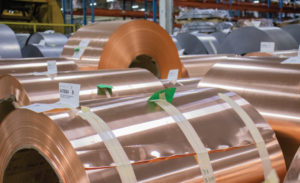Leading Trends in Home Design Featuring Stylish and Practical Copper Products
Leading Trends in Home Design Featuring Stylish and Practical Copper Products
Blog Article
How Copper Products Contribute to Sustainable Practices in Numerous Fields
Copper products are progressively acknowledged for their significant payments to sustainable methods throughout several markets, driven by their fundamental homes such as sturdiness, recyclability, and effectiveness. In eco-friendly energy systems, for instance, copper boosts the performance of solar and wind innovations, while its application in building and construction decreases waste via durability. Additionally, the material's antimicrobial features use promising benefits in healthcare settings. As sectors look for to embrace more sustainable practices, the role of copper might confirm essential in achieving environmental goals. What ramifications might this have for future innovations in sustainability?
Copper in Renewable Energy
Copper plays an important function in the advancement of renewable energy technologies, functioning as a crucial conductor in numerous applications. Its phenomenal electric conductivity and resistance to deterioration make it a suitable material for electric wiring, which is important in photovoltaic panels, wind generators, and power storage space systems. In solar photovoltaic systems, copper is made use of in the affiliations and circuitry, allowing reliable power conversion from sunlight to electrical energy.
In wind power, copper is indispensable to the generators and transformers that convert kinetic energy right into electrical energy, guaranteeing ideal performance and dependability. Additionally, the demand for electric cars (EVs) is raising, with copper being a vital part in batteries, electric motors, and charging infrastructure. The change to EVs substantially improves the demand for copper, as these vehicles typically utilize 4 times extra copper than conventional interior burning engine vehicles.
As the globe looks for to mitigate environment modification and transition to sustainable energy sources, copper's duty becomes increasingly essential. The product not just enhances the effectiveness and durability of renewable power systems but likewise sustains the broader goal of decreasing greenhouse gas discharges and advertising a sustainable future.
Eco-Friendly Building Products
Over the last few years, there has been a significant change in the direction of the fostering of environmentally friendly building and construction materials in action to expanding ecological concerns. This adjustment is inspired by the requirement for sustainable options that lessen ecological impacts while keeping architectural integrity and visual charm.
Copper, known for its toughness and recyclability, has actually become a crucial player in this market. It can be used in roof, pipes, and electric systems, contributing to energy performance and minimizing waste. Copper's long life means fewer substitutes over time, more boosting its sustainability account.
In addition, materials such as bamboo, redeemed wood, and reused steel are gaining appeal. These options not just offer decreased ecological effect however additionally promote resource conservation. As constructing codes increasingly emphasize sustainability, home builders and engineers are incorporating these materials into their jobs, fostering innovation in layout.
The boosting adoption of green building and construction products shows a broader commitment to sustainability in the constructed environment. By prioritizing these materials, the building market can dramatically decrease its carbon impact, line up with governing standards, and sustain a much healthier community for future generations. This fad notes an essential action in the direction of a much more sustainable future in building and construction.
Copper's Duty in Medical care
Current research studies have highlighted the substantial duty of copper in medical care setups, specifically due to its antimicrobial residential or commercial properties. Copper surfaces have actually been revealed to decrease the presence of pathogens, including viruses and microorganisms, by up to 99.9% within a short period. This exceptional efficiency makes copper a very useful material for high-touch surface areas in health centers, such as doorknobs, bed rails, and IV poles, consequently adding to improved infection control actions.
In addition to its direct antimicrobial effects, copper also contributes in the wider context of healthcare facility sustainability (Copper Products). By incorporating copper right into clinical equipment and home furnishings, health care facilities can lower the incidence of healthcare-associated infections (HAIs), which not only enhances patient results yet additionally decreases the prices associated with prolonged medical facility stays and extra treatments
Moreover, copper's sturdiness and recyclability straighten with sustainable practices, allowing for liable source administration. As healthcare systems progressively prioritize both individual safety and environmental stewardship, the assimilation of copper products is ending up being extra prevalent. This twin benefit highlights copper's essential contribution to a healthier, much safer, and more lasting healthcare atmosphere.
Sustainability in Transport

Moreover, copper's sturdiness and corrosion resistance add to the durability of transport facilities (Copper Products). In rail systems, as an example, copper elements improve the dependability and performance of signaling and power systems, essential for decreasing delays and power consumption. Additionally, copper's function in sustainable power systems, such as solar and wind, sustains lasting transport services by supplying clean power for electric transportation options
Investments in copper innovation not only foster sustainability but additionally promote economic growth and work production in environment-friendly sectors. As markets strive to meet strict environmental policies, the application of copper items in transport becomes a crucial technique in attaining sustainability goals and promoting a cleaner, much more efficient future.
Copper and Round Economic Situation
As the globe increasingly embraces sustainability, the duty of copper have a peek at this site in the circular economic situation comes to be ever before much more considerable. Copper's innate properties-- such as its recyclability, conductivity, and toughness-- placement it as an essential product in a resource-efficient economic situation. The circular economic situation aims to decrease waste and optimize source use through recycling and reusing materials, and copper excels in this regard.
The steel can be reused indefinitely without loss of top quality, making it a suitable prospect for sustainable practices across various sectors, including building and construction, electronic devices, and sustainable energy. By recovering and recycling copper from end-of-life products, sectors can dramatically reduce the need for virgin products, thus reducing environmental influences connected with mining and handling.
Moreover, the integration of copper right into circular economic climate frameworks not only preserves sources but likewise promotes advancement. Businesses that focus on copper recycling add to a more lasting supply see it here chain, improving their competition while aligning with regulatory needs and consumer preferences for ecologically responsible items.
Final Thought
In verdict, copper items substantially add to lasting practices across numerous markets. Their crucial role in boosting renewable resource innovations, promoting environment-friendly building and construction products, supporting infection control in health care, promoting sustainable transportation, and embodying the concepts of a circular economic situation highlights the flexibility and significance of copper. By incorporating copper right into numerous applications, industries can accomplish higher performance, lower environmental impact, and straighten with international sustainability goals, eventually fostering an extra sustainable future.

Copper's superb conductivity makes it a recommended product in electrical car (EV) systems, boosting energy effectiveness and performance. Furthermore, copper's function in sustainable energy systems, such as solar and wind, supports sustainable transport services by offering tidy power for electric transportation alternatives.
Their important role in improving sustainable power modern technologies, promoting environmentally friendly building and construction products, sustaining infection control in health care, facilitating sustainable transportation, and personifying the concepts of a round economic climate highlights the flexibility and importance of copper.
Report this page